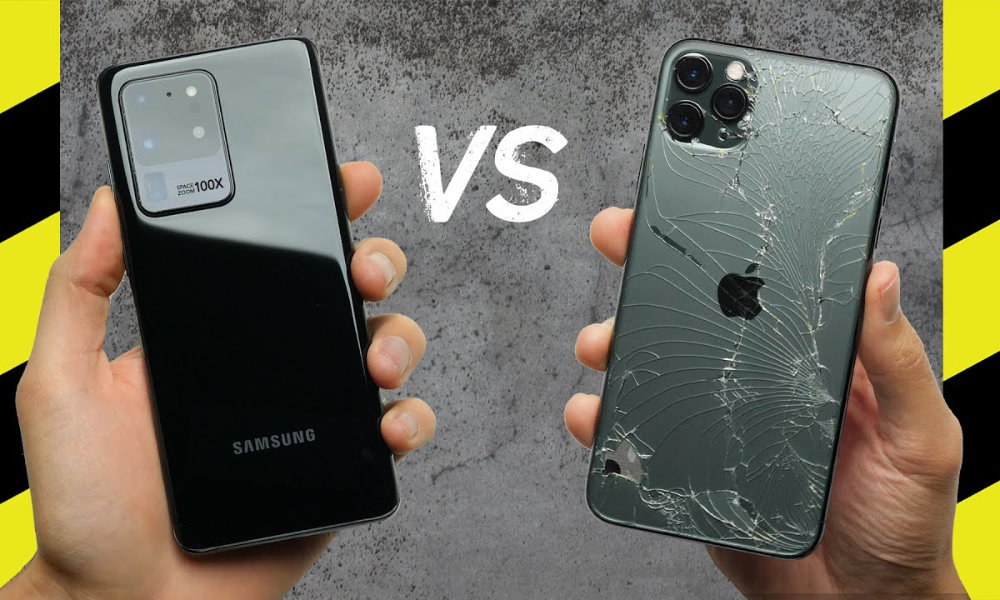New Drop Test Pits iPhone 11 Pro Max Against Samsung S20 Ultra with Surprising Results
 Credit: PhoneBuff
Credit: PhoneBuff
Toggle Dark Mode
As heavyweights Apple and Samsung get their new flagship smartphones out each year, there’s always an enterprising and adventurous Youtuber ready to sacrifice a pair of $1,000+ phones in the name of science and popularity.
Last year, it was the iPhone XS Max beating out the Samsung Galaxy S10+, and before that we saw testers trying to crack the iPhone XS on cement, pitting multiple iPhones against each other, and the now-classic iPhone 8 Plus being edged out by Google’s Pixel XL 2.
In fact, this sort of thing has been going on since at least the iPhone 7 and Galaxy Note 7 went head-to-head back in 2016, although at least Apple’s devices weren’t known for exploding. The iPhone 7 Plus was also put up against the Samsung Galaxy S8+ a few months later, with mixed results.
So it should be no surprise that with the release of Samsung’s new flagship Galaxy S20 series, the time has arrived once again to see how well Samsung’s highest-end smartphone survives against Apple’s flagship iPhone 11 Pro Max.
The Contenders
In a new video posted by PhoneBuff, a Samsung Galaxy S20 Ultra is the contender, which actually comes in larger than the iPhone 11 Pro Max, at 6.9 inches, but weighs in at slightly less — 220g vs 226g.
While Apple promises that the iPhone 11 has “the toughest glass in a smartphone” — the same claim it makes every year — Apple has always declined to say specifically what type of glass it uses, the company definitely has a relationship with Corning, so it’s fair to say that it’s likely at least some variation of Corning’s Gorilla Glass.
Samsung, on the other hand, doesn’t hesitate to promote the fact that all of its flagship phones are using Gorilla Glass 6 on both the front and back.
The Results
In the tests, both phones were subjected to four different procedures, with drops from a height of about three feet onto a concrete cinderblock, and in the first three rounds, the S20 Ultra generally did noticeably better than the iPhone, but that’s not the whole story.
In the first test, both phones were dropped flat on their back, although it’s interesting to watch how each phone lands, with the iPhone 11 Pro Max making a completely horizontal plant while the S20 Ultra bounces around a fair bit. While the iPhone sustained a fully shattered back and the S20 came out relatively unscathed, the narrator suggests that this could simply be due to the larger protruding camera lens on the S20, which appears to have taken the brunt of the drop and the damage that goes with it, adding the Gorilla Glass 6 certainly isn’t impregnable, and he’s seen it crack before in other tests. The way the S20 bounces around on impact would seem to suggest this as well.
In the second test, which saw both phones dropped on their corner, the iPhone 11 Pro Max actually came out slightly less unscathed, thanks to its stainless steel frame. However, both phones only sustained relatively minor scuffs on the corner, and there was no screen damage to either, despite the ultra-thin bezels that are used by both.
For the third test, both phones were dropped flat on their faces, and the iPhone 11 Pro Max did the same horizontal face plant as it did when dropped on its back, while the Samsung model oddly bounced around some more. The result was a spiderweb crack across the iPhone’s screen, although this didn’t impact the usability of the iPhone at all. The S20 Ultra sustained less damage, with the cracks constrained to the edge of first impact, although again it’s hard to tell whether this was due to the use of stronger glass of the slight curvature of the screen.
In the fourth round, however, which involved dropping each phone ten times, Apple’s iPhone 11 Pro Max actually came out far better. After 10 drops, it wasn’t a pretty sight, but the damage appeared to be almost entirely cosmetic. The rear camera system was rendered unusable, but the touchscreen was still fully responsive despite the cracks, the actual OLED display remained undamaged, and the speakers and even Face ID continued to work just fine.
The S20 Ultra didn’t fare nearly as well to repeated drops, with the first extra drop shattering the glass more fully and rendering the in-display fingerprint sensor only about 20 percent functional, and by the second additional drop the touchscreen became unresponsive. After the ninth drop, the OLED display was significantly damaged to the point of being one-third unreadable and the touchscreen was not only completely unusual but also was rendering phantom touches throughout.
So the bottom line seems to be that while the iPhone 11 Pro Max may encounter more physical glass damage after even a single drop, the actual hardware components underneath the glass are clearly built to last. Obviously it’s hard to believe anybody would actually drop either phone that many times in the real world without deciding to use a case at some point, and of course drop tests don’t always simulate real-world conditions, but what this seems to demonstrate is that the iPhone’s apparent fragility is really only skin deep.






